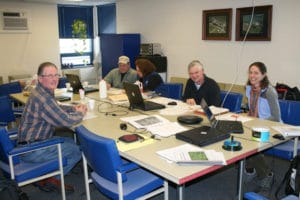Howland Dairy Benefits from Whole Farm Analysis Project
The Whole Farm Nutrient Analysis Program (WFA) came along at the right time for Rob Howland of Candor, NY. Howland’s 74 cow dairy is one of eleven farms in the WFA project, an initiative of Cornell’s Nutrient Management Spear Program (NMSP). The WFA identifies opportunities for change in nutrient inputs or allocations that could benefit the environment and the farm’s bottom line. The nutrient efficiency of a farm’s component areas are measured and analyzed with an integrated approach.
The Nutrient Management Spear Program (NMSP) is an applied research, teaching and extension program for field crop fertilizer and manure management on dairy and livestock farms. It is a collaboration among faculty, staff and students in the Department of Animal Science, Cornell Cooperative Extension, and PRO-DAIRY. Our vision is to assess current knowledge, identify research and educational needs, facilitate new research, technology and knowledge transfer, and aid in the on-farm implementation of strategies for field crop nutrient management including timely application of organic and inorganic nutrient sources to improve farm profitability while protecting the environment. An integrated network approach is used to address research, extension and teaching priorities in nutrient management in New York State. For more information on NMSP projects and extension/teaching activities, visit the program website or contact Quirine Ketterings at qmk2@cornell.edu or (607) 255-3061.
Howland described his reaction when approached by his Extension Field Crops Specialist, Janice Degni to participate in the project. “I immediately said that I would. I was aware of the concerns in society about the environment, and as a dairy farmer, business economics are always a personal concern. This farm has a fairly large land base, and I was questioning where in the crop system I would get the best return from my time and dollars.”
There are several stand-alone tools used to evaluate a farm’s nutrient status that tend to analyze a particular sector of the farm. An objective of the WFA project is to combine those tools and extract the data that are most essential for assessing nutrient status and providing valuable information to the farmer.
Patty Ristow, Extension Associate with the NMSP, explained the WFA process, “The first step is to compile accurate and relevant information to analyze the farm’s nutrient status. On the field side this consists of three key tools: a Whole Farm Nutrient Mass Balance (NMB), soil fertility analysis of all the fields, and nitrogen measures termed adaptive N management in corn fields.”
The NMB provides a mechanism for tracking nutrient use efficiency across the whole farm year after year. The analysis covers four farm production sectors: milk, animals, crops and feed. The NMB diagnostic reports quantify the net major nutrients that remain after subtracting nutrients exported from those imported to the farm.

During team meetings farm data were reviewed to identify nutrient status of the farm and potential opportunities to improve.
The year-end data summary requires routine record-keeping for each production sector. That can make it challenging to complete, but Ristow noted that its role is crucial. “The NMB diagnostics have helped illustrate to farm management teams and environmental regulators that our farms’ management changes are greatly reducing the amount of nutrients that could affect water resources. By tracking changes over time a powerful message is delivered from the whole farm perspective.”
Howland commented further, “At first I didn’t find the NMB to be useful. Getting the data together was tough, because it didn’t fit with my record keeping system. After about two years I made some adjustments in tracking forage inventory, and that’s helped both the NMB data needs and my feed system. I started tracking my baleage more specifically as to time of cutting and the field it came from. As yields have increased from the same number of acres, sales of baleage are taking nutrients off the farm as well as providing income. I now view hay quality as a nutrient efficiency issue as well as an economic one. The NMB also shows that I buy the same amount of feed as before the project, but I make more milk now from 74 cows than I did several years ago with eighty.” A complete stall renovation in Howland’s barn also contributed to increased milk production from fewer cows. The integration of forage quality with crop exports and increased milk sales has led to a reduction in nutrients remaining on the farm.
Ristow commented on the diagnostic impact of the program’s approach to soil nutrient analysis. “WFA summarizes and displays the results across an entire farm. This shows a clear picture of where approximately 70% of nutrients brought onto the farm as feed ultimately end up in the form of manure. Uneven distribution of nutrients on cropland indicates an opportunity to change manure spreading and fertilizer application practices.”
Howland noted that the soil fertility information from the WFA was immediately useful. “I knew those fields close to the barn would have high nutrient levels, but the project showed me those levels over time. I have a much clearer idea of how much manure should or shouldn’t go on the various fields. Some of our hill fields are nutrient hungry, and now we prioritize spreading there whenever the weather allows.”
Ristow noted the impact of Howland’s participation on the project’s development. “Rob’s input has been a tremendous help in creating report formats that are useful management tools. His feedback was vital, because the information must make economic sense to him and clearly benefit his business. If farmers can’t readily draw conclusions from the information we provide, it’s unlikely to be applied to management decisions.”

Rob Howland used the Whole Farm Analysis tools to identify current nutrient status of the farm and to identify potential opportunities to improve.
The project takes nutrient management a step farther by utilizing two adaptive management tools for nitrogen in corn fields. The Illinois Soil Nitrogen Test (ISNT) can be taken prior to crop planting and predicts the soil’s ability to supply N to the crop by determining the amount available to mobilize from the pool of organic N. The Corn Stalk Nitrate Test (CSNT) is a nitrate analysis of the bottom portion of the corn stalks at harvest time. It tells the story of how the prediction of N supply and use of fertilizer and/or manure played out in reality. These two tools together allow for fine-tuning of N applications over time and on a field by field basis.
Looking to the future, the program hopes to integrate economic measures from Cornell’s Dairy Farm Business Summary into the WFA diagnostics, identifying factors of profitability that correlate with nutrient efficiency. This could provide financial documentation to the benefits seen by WFA participants. Ristow commented: “The changes made as a result of tracking the NMB and fine-tuning nutrient distribution and nitrogen use on corn often result in reduced purchases and alleviate excessive nutrient levels that may affect water resources. It’s a win-win scenario for the farm’s economics and the environment.
“Howland summarized his opinion of the WFA project.” Participating in this type of project raises your level of consciousness as it puts the farm’s nutrient use facts in front of you. If something looks high, you have the tools to consider how to change that.” Noting the fit between the WFA project and his business philosophy, he added, “It’s important to know what the issues are that can affect your business. You can’t farm in a vacuum.”

